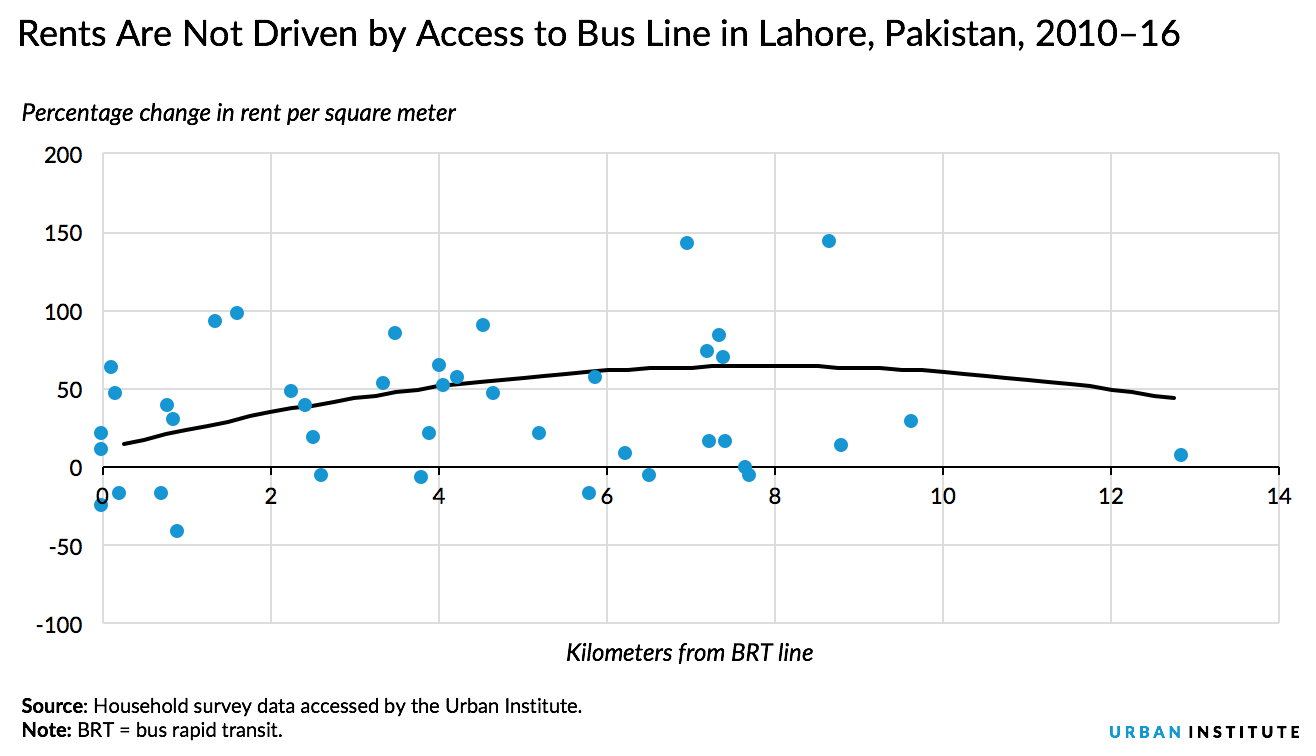
This post has been edited to reflect that Lahore's orange line train is under construction.
Urban residents around the world know that housing close to mass transit commands a price premium. Living near transit stations saves residents time and money, which is reflected in rents.
Studies evaluating the impact of bus rapid transit (BRT) services in Beijing, China, and Brisbane, Australia, have found rents of properties near stations to be 10 and 20 percent higher than those farther away. The value of properties within six miles of mass urban transit are known to increase two to three times faster than those outside.
But does this relationship hold true everywhere? And what factors complicate it?
Case study: Lahore, Pakistan’s first BRT
Railway connectivity in the late 19th century solidified Lahore’s status as the major trading hub between Central Asia and the Indian subcontinent, and business activity continues to be concentrated in the vicinity of the main railway station.

Despite increasing sprawl in recent years, rents decrease with distance away from the railway station, which is consistent with the classical theory of urban land markets. One might assume the trend would apply to other public transportation initiatives as well.
But that’s not necessarily the case. Launched in February 2013, the flat-rate, 20-cent-a-ride Lahore “metrobus” was dubbed a “game-changer” for the city’s transport system, transporting around 200,000 passengers along the critical 17-mile corridor connecting neighboring cities Sheikhupura and Kasur.
As a cheaper transportation alternative connecting the north and south ends of the city while passing through job centers, people expected that greater demand for residences would result in rent premiums in adjoining areas.

But our analysis of rental changes over five years indicates that was not always the case. During that period, neighborhoods experienced dramatic variations in rent, with some rents dropping 41.3 percent and others rising 434 percent, without any apparent correlation with distance to transit.

Note: the orange line train is currently under construction.
Besides obvious factors such as building age, location, and household income, rent variation is mostly explained by access to and expenses for solid waste management, electricity, water, Internet, and natural gas. In fact, total monthly spending on all utilities explains the predictability of rent changes 43 times more than distance to transit. Counterintuitively, perhaps, housing rents in Lahore are clearly driven by factors other than proximity to transit.
What can policymakers learn from this analysis?
Public transportation can be an asset for communities, but our analysis reaffirms the critical role of widespread access to urban public services for economic growth and enhanced productivity.
As we discovered in recent work, in most of 42 sampled cities in Asia and Africa, urban local governments are not given the authority to manage their own affairs. Most mayors can’t even appoint or remove heads of their city’s water, sanitation, or transport utility providers, let alone set user fees with rising operational expenditures.
Despite these limitations, at least 113 cities across Asia, Africa, and Latin America now have BRT systems in operation, with many more in various stages of planning and implementation. Despite needing relatively high capital investments, their highly visible nature and perceived economic growth benefits make them popular—and politically attractive—even in poorer cities.
But there’s no silver bullet for prioritization across competing public spending needs. Far from a technical exercise evaluating merits of policy options, decisionmaking is always grounded in local political economies. As in the case of Lahore, however, urban transport investments are often made without proper community consultations, resulting in solutions agnostic to users’ needs and failing to stimulate local economic activity.
Although politically and administratively challenging, rapidly urbanizing countries facing massive infrastructure deficits must reform governance institutions by increasing citizen engagement and delegating decisionmaking to local authorities.
Tune in and subscribe today.
The Urban Institute podcast, Evidence in Action, inspires changemakers to lead with evidence and act with equity. Cohosted by Urban President Sarah Rosen Wartell and Executive Vice President Kimberlyn Leary, every episode features in-depth discussions with experts and leaders on topics ranging from how to advance equity, to designing innovative solutions that achieve community impact, to what it means to practice evidence-based leadership.